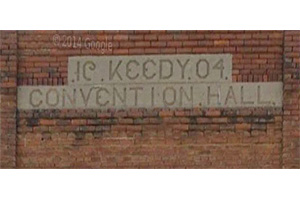 |
||||||||||||||||||||||||||||||||||||||||||||||||||||||||||||||||||||||
|
||||||||||||||||||||||||||||||||||||||||||||||||||||||||||||||||||||||
 |
 |
||||||||||||||||||||||||||||||||||
A humble start to this year's entry. Population: 3,460, give or take a few souls. It has ambition, though: the hotel no doubt made everyone think of the bustling train depot in old Gotham, with its brisk, sophisticated cosmopolitan scene.
It has a Facebook page. One comment: "The rooms are clean upon arrival but not much by way of getting towels and tp on a regular basis if your stay is extended. We ended up having to buy our own. Owners are really friendly though." That counts for more than you might think,
Unhappy brickwork on that green building. But a ghost sign redeems the view:
Owl Cigars. But was it a White Owl? That's what I don't know. Some signs for the White Owl brand said just Owl. If they'd have had modern marketing sensibiilties, they would have had White Owl, Black Owl, and so on, differentiating the flavors. Barn Owl for the really nasty cheroots.
And what, pray tell, do they sell here?
I have no idea what they're talking about. One guy sitting at a card table with a stack of daily periodicals, waiting for someone to walk by and think "by cracky, I wonder how many they have. I'd like to read a journal from a different city entirely, just to see how many funerals there are for old ladies this week."
That's a lot of turret, Mr. Hetzel.
A Nebraska historical journal says "A majority of the structures are best classified as commercial vernacular. The most prominent, Queen Anne-style building is the Hetzel Block (NH01-044), located on the southeast corner of J Street and Central Avenue. It features an imposing corner tower, carved stonework and an ornate cornice." And that's a big fat lot of help. Who was Hetzel?
Four buildings? Or one?
As if a curse had stricken the land.
I have to think there was more to this one, but what remains is spectacular:
The reason for those windows? If you guessed "hall for secret Masonic rites," you're wrong. It was the New Opera House. Again, scant historical information; Auburn seems underwhelmed by its past, or disinclined to share what it knows.
Can't have the Main Streets feature without the OSA, or Obligatory Shingled Awning:
The first-floor windows above the main windows are probably bricked up for good, but the building looks like it could be restored with minimal work. Providing there was a market for office / residential at the price it would take to fix it up, and I'm guessing there isn't. But that's what they said about Fargo before its renaissance.
The last building in the world you'd expect to house a theater:
I believe this old book of biographies has our man:
There has to be a fascinating story about the reason a man named Keedy would leave Keedysville. |
|||||||||||||||||||||||||||||||||||
|
 One of my vows this year was “no more two-parters.” If I have a lot of pictures, you’ll get them all. Why, otherwise you’d forget whatever misimpression I gave you the first time, and form a new misimpression without the cherry-picked evidence I’d shown last week.
One of my vows this year was “no more two-parters.” If I have a lot of pictures, you’ll get them all. Why, otherwise you’d forget whatever misimpression I gave you the first time, and form a new misimpression without the cherry-picked evidence I’d shown last week.




































